Dominican Republic is a nation on an island shared with Haiti on the east, this island is part of the Great Antilles archipelago between the Caribbean region and North Atlantic Ocean. The Dominican Republic has an incredibly rich history. The walls and the cobblestoned streets of its Colonial City bear witness to its past as the first city founded in the Americas.
-
History
On December 5, 1492, Admiral Christopher Columbus arrived on the island. He named it Hispaniola, setting into motion the meeting of two cultures.
For at least 5,000 years before Christopher Columbus discovered America for the Europeans, the island, which he named Hispaniola, was inhabited by indigenous peoples whom he called “Indians”. The peaceful Taino Indians, who spent their days hunting, fishing and farming, first inhabited the island. The word Taíno meant “good” or “noble” in their language, which they showed Columbus and his Spanish crew with their peaceful and generous hospitality.
The history of the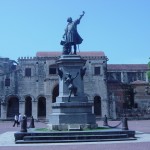 Dominican Republic is an interesting one. Incredibly enough Christopher Columbus, discovered this island by mistake, in fact, the city of Santo Domingo was the first real European settlement in the Americas, having been founded more than 500 years ago.
Dominican Republic is an interesting one. Incredibly enough Christopher Columbus, discovered this island by mistake, in fact, the city of Santo Domingo was the first real European settlement in the Americas, having been founded more than 500 years ago.
The capital city of Santo Domingo was founded or built over a period of two years, from 1496 to 1498. It quickly became the representative seat of the Spanish royal court and thus was an important city of power and influence in the New world.
The Conquests and Modern History
Both France and Spain have actually controlled the island at different points in time, and the United States actually held a presence in the country for a brief period as well.
The first permanent European settlement, Isabella, was founded in 1493, on the north coast of the island, not far from where Puerto Plata is now. From there the Spaniards could exploit the gold in the Cibao Valley, a short distance away, in the interior of the country.
Columbus’ brother, Bartholomew, was appointed governor while Christopher continued his explorations in the Caribbean region. After the discovery of gold on the island´s southern coast, Bartholomew founded the city of Santo Domingo in 1496. The Spaniards were jealous of the Columbus brothers’ (Italian) leadership and so began accusing them of mismanagement when reporting back to Spain. These complaints had them relieved of their positions and Christopher and his two brothers were brought back to Spain in chains. Once there, it became evident that most of the accusations against them had been grossly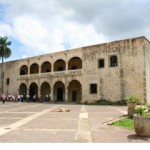 exaggerated and Queen Isabella ordered their release.
exaggerated and Queen Isabella ordered their release.
By 1515 the Spaniards realized that the gold deposits of Hispaniola were becoming exhausted. Shortly thereafter, Hernándo Cortés and his small retinue of soldiers made their astonishing conquest of Mexico, with its fabulous riches of silver. Almost overnight the colony on Hispaniola, which was usually called Santo Domingo after its capital city, was abandoned and only a few thousand “Spanish” settlers remained behind (many of whom were the offspring of Spanish fathers and Taíno mothers). Columbus’ introduction of cattle and pigs to the island had multiplied rapidly, so the remaining inhabitants turned their attention to raising livestock to supply Spanish ships passing by the island en route to the richer colonies on the American mainland. Hispaniola’s importance as a colony became increasingly minimized.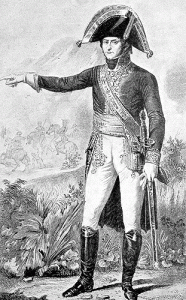
Inspired by events taking place in France during the French Revolution and by disputes between whites and mulattos in Saint Domingue, a slave revolt broke out in the French colony in 1791, and was eventually led by a French Black man by the name of Toussaint L’ouverture. Since Spain had ceded the Spanish colony of Santo Domingo to France in 1795, in the Treaty of Basilea, Toussaint L’Ouverture and his followers claimed the entire island.
The French retained control of the eastern side of the island, however, and then in 1809 returned this portion to Royal Spanish rule. The Spaniards not only tried to re-establish slavery in Santo Domingo, but many of them also mounted raiding expeditions into Haiti to capture Blacks and enslave them as well.
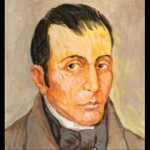 Due to the neglect of the Spanish authorities, the colonists of Santo Domingo, under the leadership of José Núñez de Cáceres, proclaimed what came to be called the Ephemeral Independence.
Due to the neglect of the Spanish authorities, the colonists of Santo Domingo, under the leadership of José Núñez de Cáceres, proclaimed what came to be called the Ephemeral Independence.
In 1822, fearful the French would mount another expedition from Spanish Santo Domingo to re-establish slavery, as they had threatened to do.
Haiti’s President Jean-Pierre Boyer sent an army that invaded and took over the eastern portion of Hispaniola. Boyer once again abolished slavery and incorporated Santo Domingo into the Republic of Haiti.
For the next 22 years the whole island of Hispaniola was unified under Haitian control–Dominicans call the period “The Haitian Occupation.” Due to their loss of political and economic control, the former Spanish ruling class deeply resented the occupation. During the late 1830s, an underground resistance group, La Trinitaria, was organized under the leadership of Juan Pablo Duarte.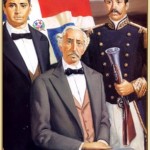
After multiple attacks on the Haitian army, and because of internal discord among the Haitians, the Haitians eventually retreated. Independence of the eastern two-thirds of Hispaniola was officially declared on February 27, 1844, and the name República Dominicana (Dominican Republic) was adopted.
From this time on the Dominican Republic was almost constantly under the rule of caudillos, strong military leaders who ruled the country as if it were their personal fiefdom. Over the next 70 years, the Dominican Republic had multiple outbreaks of civil war and was characterized by political instability and economic chaos.
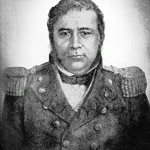 For the next quarter of a century, leadership seesawed between that of General Pedro Santana and General Buenaventura Báez, whose armies continuously fought each other for political control. In an effort to maintain some type of stability, the two military leaders and their armies resorted to outside assistance.
For the next quarter of a century, leadership seesawed between that of General Pedro Santana and General Buenaventura Báez, whose armies continuously fought each other for political control. In an effort to maintain some type of stability, the two military leaders and their armies resorted to outside assistance.
In 1861, General Pedro Santana invited Spain to return and take over its former colony. After a short period of mismanagement by Spain, the Dominicans realized their mistake and forced the Spaniards out so they could restore the Republic. Another attempt was made for stability when Dominicans invited the United States to take over a decade later. Although U.S. President Grant supported the request, it was defeated by the U.S. Congress.
During the 19th century, the country’s economy shifted from ranching to other sources of revenue. In the 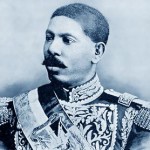 southwestern region, a new industry arose with the cutting down and exporting of precious woods like mahogany, oak, and guayacán. In the northern plains and valleys around Santiago, industry focused on growing tobacco for some of the world’s best cigars, and on coffee.
southwestern region, a new industry arose with the cutting down and exporting of precious woods like mahogany, oak, and guayacán. In the northern plains and valleys around Santiago, industry focused on growing tobacco for some of the world’s best cigars, and on coffee.
For 1882, General Ulysses Heureux, known as “Lilis,” came into power. His brutal dictatorship consisted of a corrupt regime that maintained power by violent repression of his opponents. Lilis handled the country’s affairs so poorly that it regularly rocked back and forth between economic crisis and currency devaluations. Following his assassination in 1899, several individuals came to power, only to be rapidly overthrown by their political opponents, and the country’s internal situation continuously degenerated into chaos.
Around the turn o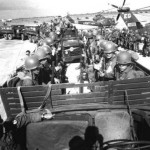 f the century, the sugar industry was revived, and so many Americans came to the Dominican Republic to buy plantations that they came to dominate this vital sector of the economy. In 1916, the U.S. occupied the Dominican Republic for 8 years.
f the century, the sugar industry was revived, and so many Americans came to the Dominican Republic to buy plantations that they came to dominate this vital sector of the economy. In 1916, the U.S. occupied the Dominican Republic for 8 years.
Re-modeling of the legal structure took place, allowing them to create a better economy. Although many Dominican businessmen experienced losses due to these changes, the political violence was eliminated and many improvements in the Dominican Republic’s infrastructure and educational system were introduced.
The troops remained until 1924. The country fell under the control of Rafael L. Trujillo in 1930 and remained under his government until his assassination in 1961. Trujillo’s government was a dictatorship. 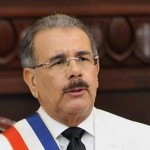
Juan Bosch was democratically elected as the leader of the country in 1962, but a civil revolt shortly after ushered in another intervention by the US military.
The country has enjoyed a democtratic government since 1966, with democratic elections held since that time for various public offices.
.In May of 2012 the most recent Presidential Elections were held, with Danilo Medina winning the election as the new President of the country.
-
Geography
The Dominican Republic is located on the Island of Hispaniola, which it shares with Haiti. The country has an area of 48,442 square kilometers, or about 18,000 square miles which take up about 2/3 of the island. The Dominican Republic offers some of the most beautiful and diverse topography in the Caribbean. The country has a population of about 8 Million inhabitants.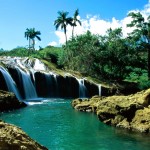
The Dominican landscape is frequently forested and often undulating, with a multitude of valleys, plains and plateau. The soil is fertile with excellent white beaches on the north, southeast and east coasts.
Dominican Republic has several national parks and science reserves, and, in spite of occasional hurricanes and fires, these areas remain largely intact. Today there are 17 national parks in the Dominican Republic.
The island has a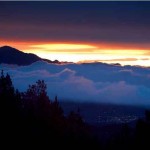 year round tropical weather, the average temperature is 80 degrees Fahrenheit or 25 degrees Celsius. It does cool down slightly during November to January.
year round tropical weather, the average temperature is 80 degrees Fahrenheit or 25 degrees Celsius. It does cool down slightly during November to January.
Dominican Republic has a series of mountain belts stretch across the border region, most notably in the form of the Cordillera Central; at 3,175m (10,414ft) the peak of Pico Duarte represents the highest point of the country.
Snow or frosts have been reported at the highest elevations of Pico Duarte from December through February, so beach attire is out if you are heading up that way during these months.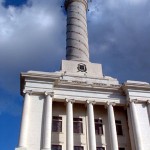
Santo Domingo is the capital city, situated on the southern portion of the island. Since the city is located directly on the coast, it is a major center of seaport activity.
While Santo Domingo is the nation’s capital, Santiago truly is the capital of the tobacco and cigar industry. Cigar manufacturers, such as Leon Jimenez and many others, all have their operations in or near Santiago.
The country is ideally located close to Puerto Rico and the United States. A plane flight from San Juan, Puerto Rico takes about 40 minutes and less than 3 hours from major American cities, such as New York. A direct flight from Miami is the quickest, with about a 1 1/2 hour flying time.
-
Culture and Language
The complex heritage of Arawak, Spanish, African, and French traditions, plus an early independence, set the Dominican Republic apart from other Caribbean islands.
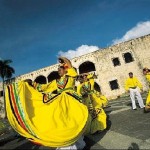 The culture of the Dominican Republic has been influenced by a huge range of variables, from the arrival of European colonizers, and U.S. occupation. Without doubt, the turbulence of the Dominican Republic’s history has impacted its culture greatly.
The culture of the Dominican Republic has been influenced by a huge range of variables, from the arrival of European colonizers, and U.S. occupation. Without doubt, the turbulence of the Dominican Republic’s history has impacted its culture greatly.
There are many historic museums and buildings that take a unique look into Dominican culture. Among them are the Alcázar de Colon, the Reloj de Sol, and the monasterio de los Padres Dominicos.
Cultural products such as Dominican art and literature have been shaped by the changing conditions throughout history.
There are areas of culture that are truly unique and a source of great pride for the Dominican people. Music and dance is a 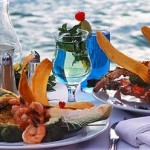 prime example, the colorful and diverse Bachata and Merengue are great symbols of Dominican culture.
prime example, the colorful and diverse Bachata and Merengue are great symbols of Dominican culture.
With regards to Dominican society, there has always been a strong belief in the power of the family unit. The strong family structure has ensured that cultural characteristics, such as Dominican customs, holidays and even the cuisine have remained strong against the waves of upheavals.
Most of the inhabitants are mostly Catholic, followed by other denominations of Christianity.
Spanish is the official language. Some English is spoken in Santo Domingo, particularly within the tourist industry. Some Creole is spoken near the Haitian border and in the sugarcane villages, where many Haitian workers live.
-
Economy
The Dominican Republic has long been viewed primarily as an exporter of sugar, coffee, and tobacco, but in recent years the service sector has overtaken agriculture as the economy’s largest employer, due to growth in telecommunications, tourism, and free trade zones.
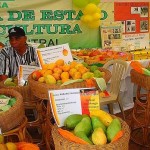
The economy in the Dominican Republic is highly dependent upon the US, the destination for nearly 60% of exports.
Remittances from the US amount to about a tenth of GDP, equivalent to almost half of exports and three-quarters of tourism receipts.
The growth of the Dominican Republic’s economy rebounded in 2010 from the global recession, and remains one of the fastest growing in the region.
-
Flora and Fauna
For some visitors the nature will be the primary attraction to visit the Dominican Republic, while for others it will be an added delight to the warm tropical air and beautiful beaches. The best places to see the incredible variety of plants, trees, birds, reptiles and other animal life found in the Dominican Republic is to visit its National Parks and Protected Areas. The Dominican flora and fauna is not dangerous.
Iguanas
The rhinoceros iguana is an endangered species endemic to Hispaniola, and are most commonly found in the Enriquillo Basin. 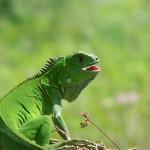
Their size and their uniform gray color explains why they are called rhinoceros iguana.
They live on plants and berries and are active only by day. The other species of iguana found in the Dominican Republic is the ricord iguana.
Turtles
The four main types of turtle living off the Dominican coast are the leatherback, the loggerhead, the hawksbill.
American Crocodile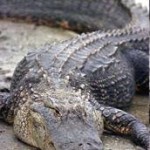
In Hispaniola, the American crocodile is so well established that it represents one of the largest wildlife crocodile populations in the world. In the Dominican Republic, its favorite haunt is the brackish water of Lake Enriquillo.
The best time to see them on land is during the early morning or late afternoon when they emerge from the water to raise their body temperature under the sun’s rays.
Coral Reef
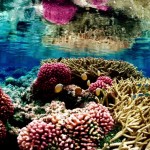
Scuba diving and snorkeling are two of the most popular activities on a trip to the Dominican Republic due to the vast existence of Coral Reef surrounding the Island.
There are hundreds of species in both the fringing reef and the bank/barrier reef. These include corals, sponges, worms, mollusks, crabs, lobsters and fish.
Birds
The considerable bird population in the Dominican Republic is made up of indigenous species and wintering birds from the North American mainland.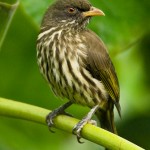
Look out for species such as the Hispaniolan parrot, the Hispaniolan woodpecker, the rarer Hispaniolan trogon and Hispaniolan parakeet, the palmchat, and several types of owl and pigeon, including the endangered white-crowned pigeon.
Around the coast plenty of shorebirds can be seen. Great egrets, American frigate birds, brown pelicans, blue herons, glossy ibis, ruddy ducks and flamingos are all relatively common, especially on the off-shore islands of the Dominican Republic and around the numerous lakes and lagoons on the mainland.
In the mountains, there are yet more species such as the Antillean siskin, the white-necked crow, the green-tailed warbler and numerous types of butterfly and hummingbird.
Land mammals
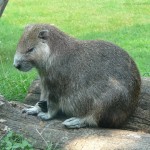 The Caribbean in general does not have many land species, and the Dominican Republic is no exception.
The Caribbean in general does not have many land species, and the Dominican Republic is no exception.
Most of the mammals you see in the country today were introduced by the Europeans.
In fact, there are only two endemic land mammals in Hispaniola, the solenodon and he hutia, the chances of spotting either of these animals on your travels are slim.
Marine mammals
The West Indian manatee can sometimes be seen in the coastal areas of the national parks or in Samana Bay.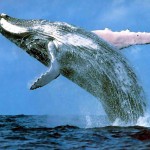
One of the principal breeding grounds in the world for humpback whales is on the Silver and Navidad banks off the north coast of the Dominican Republic.
Each winter some 3,000 whales migrate from their feeding grounds in the North Atlantic, and congregate here to reproduce in shallow waters protected by coral reefs and free of boats and other distractions.
Nearer to the mainland, Samana Bay is also a popular spot for whale watching, which has become an important tourist activity during the months of January, February and March.
-
Beaches
The clear blue water and the white sand beaches are a must-see for any Dominican Republic visitor; even for locals, the beautif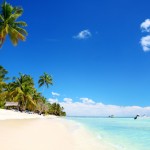 ul beach just doesn’t get old.
ul beach just doesn’t get old.
We made a list of beautiful beaches, there are many more in Dominican Republic, but we want to share these with you:
Playa Boca Chica: The beach of immaculate fine sand is still one of the best in the Caribbean. The gin-clear waters are protected by coral reefs, making Playa Boca Chica one of the most family-friendly of all the strips of sands in the Island. Lined with coconut palms, the wide beach is a brilliant stroke of nature.
Punta Cana/Bávaro Beaches: One of the world’s greatest beach strips is centered at Punta Cana and Bávaro on the eastern coast of the Dominican Republic.
This stretch of beachfront goes on for about 30km (20 miles) and is renowned for its all-inclusive resorts, the largest concentratio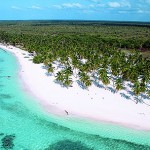 n in the Caribbean. The beaches here are wide, filled with golden sand, gorgeous, and safe for swimming all year.
n in the Caribbean. The beaches here are wide, filled with golden sand, gorgeous, and safe for swimming all year.
Cayo Levantado: On the peninsula of Samaná, along the east coast of the Dominican Republic, this island near the mouth of Bahía de Samaná lies 7km (4 1/3 miles) southeast of the town of Samaná. It can be reached easily by boat.
Once in Samana, beach lovers will find three beautiful strips of white sand. A tropical forest covers much of this hill-studded island, and when not enjoying the beach, you can go hiking along trails that are cut through the junglelike vegetation.
Playa Rincón: On the eastern shoreline of the Peninsula of Samaná, Playa Rincón is consistently hailed by Condé Nast Traveler as one of 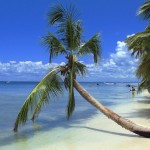 the 10 top beaches in the Caribbean, and we agree that it deserves such an accolade.
the 10 top beaches in the Caribbean, and we agree that it deserves such an accolade.
Set against the 600m (1,970 ft.) cliffs of Cape Cabrón, the beach is hard to reach, but once you’re here you can wander a Robinson Crusoe tropical paradise of white sands. This beach is ideal for snorkeling.
Playa Dorada: This is the most celebrated beach along the Amber Coast and the site of a large concentration of all-inclusive resorts. Water-skiers and windsurfers alike take delight here.
-
Sports
Baseball
With over 410 Dominican born players in the major leagues between 1958 and 2004 it is no wonder the sport of baseball is the top sport of this country and with every city, town and village has a field dedicated to playing the game.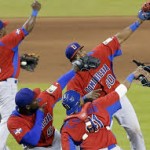
Major League Baseball in the Dominican Republic had become internationally recognized as the home of Winter Baseball. Today Sammy Sosa, Pedro Martinez, Alex Rodriguez, Manny Ramirez and many others, proudly carry the Dominican Flag in the international arena.
There are 5 pro teams: Tigres Del Licey, Leones de Escogido, Estrellas Orientales, Águilas Del Cibao and Azucareros Del Este. Each team play a sixty game schedule that begins the end of October and runs to February; the season ends in a round-robin play-off with the two finalist advancing to the Caribbean Series to play against the champions of Mexico Venezuela and Puerto Rico.
Cockfighting
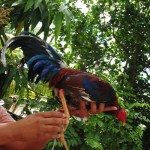 Cockfighting is a legal sport in the Dominican Republic.
Cockfighting is a legal sport in the Dominican Republic.
If you are visiting this island and are interested in seeing a match just ask a Dominican and he or she can direct you to the local arena giving you times and entry fee costs without a blink of an eye.
No matter your reason for attending you will have something definitely different to talk about when you return home.
Other Sports
The Dominican Republic’s climate creates the perfect environment for sports. Whether your gam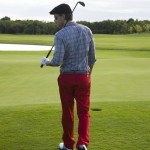 e is golf, diving, windsurfing, fishing or sailing on the high seas, sports are an exciting way to experience this country’s natural beauty, beaches, mountains, waterfalls and amazing countryside.
e is golf, diving, windsurfing, fishing or sailing on the high seas, sports are an exciting way to experience this country’s natural beauty, beaches, mountains, waterfalls and amazing countryside.
The Dominican Republic is the perfect location for all kinds of sporting events.
Dominican Republic hosts leading international tournaments such as windsurf and kiteboarding in Cabarete, fishing tournaments at Cabeza de Toro and golf courses around Punta Cana.
-
RELATED LINKS
